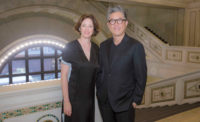New York champions design in municipal projects from fire stations and garages to libraries and courthouses.
| Photo © Nicholas Buccalo |
Click the image above to view recent civic projects in New York City. |
Located in Hunters Point — a formerly industrial neighborhood in the midst of a transformation every bit as sweeping as its view of Manhattan across the East River — a new branch of the Queens Public Library, designed by Steven Holl Architects, will be the jewel in a crown of several projects slated for the area. In their design, Holl and senior partner Chris McVoy blow apart the Carnegie library archetype, punching irregularly shaped windows into an 80-foot-tall facade clad in aluminum panels. These curvy openings will showcase the movement of bodies, like video game characters on an iPad screen, to underscore the library’s evolution from a place that circulates books to one where communities mix and mingle.
When it opens in 2013, the Hunters Point library will join scores of other new branches, cultural facilities, police stations, firehouses, and clinics constructed during New York City’s civic building boom of the last decade. The city’s Department of Design & Construction (DDC), which manages these projects, has become a sterling advocate for innovative architecture. The bureau has not only had a positive impact on neighborhoods in all five boroughs, it has been an important source of commissions for the city’s architects. The DDC also helped institute a high-performance building program to promote New York City sustainability, paving the way for a law passed in 2005, which mandates that most municipal construction projects that cost more than $2 million must achieve a minimum LEED Silver certification. Doing public work has become alluring for architects who want to create “buildings that are clearly about the user,” says Rick Bell, executive director of the AIA’s New York chapter.
The DDC completed nearly $6 billion in new projects and upgrades between 2002 and 2010, and is currently managing the construction of nearly $3 billion more, with $2 billion in additional building in the pipeline. It’s a staggering amount that recalls the days of master builder Robert Moses. In spirit, however, it may more closely resemble Mayor John Lindsay’s Urban Design Group, which sought to bring high-quality architecture to public projects in the late 1960s.
While Mayor Michael Bloomberg often gets credit for the DDC’s success, his predecessor, Rudolph Giuliani, actually created the agency in 1996. But it was Bloomberg who tapped David Burney to become DDC commissioner in 2004. An architect by training, Burney was previously the director of design and capital improvement for the housing authority. One of his first initiatives at the DDC was to create the Design and Construction Excellence (D+CE) program. “When you think about all five boroughs and how much is controlled by the city — the streets, the museums, the libraries — civic architecture is responsible for quite a lot of our environment,” Burney says. “That makes design quality all the more important, right down to the smallest projects.”
The D+CE did away with a procurement process that awarded design contracts to the lowest bidder. In its place, Burney created a quality-based system in which architects apply to join an approved roster. Twenty small firms vie for jobs under $15 million, while eight large offices compete for those between $15 and $50 million All architects, including others beyond the list, may go after the biggest projects — the largest to date has been Perkins + Will’s New York City Police Academy in Queens. With few exceptions, design fees depend on the construction budget: A certain percent for projects under $15 million and another for those over it.
The D+CE program echoes that of the Federal General Services Administration, led until 2005 by Ed Feiner, whom Burney refers to as his mentor. But the federal program relies on well-established architects, while Burney seeks younger and smaller firms.
“A program like this really means everything to us,” says Sara Caples, one-half of the husband-and-wife team Caples Jefferson, whose work for the city includes the Weeksville Heritage Center in Brooklyn — an exhibition building and park incorporating the 200-year-old houses of freed slaves — and an addition to the Queens Theatre in the Park. “It’s allowed us to win national design awards and be published around the world.”
The New York office of the British firm Grimshaw Architects has doubled in size since taking on projects that include renovating the Queens Museum of Art, as well as designing a new Fulton Street Transit Center and the Via Verde housing complex. “We can do what architects were doing 75 or 100 years ago when they were building great public libraries and so forth,” says partner Andrew Whalley.
Such civic work helps architects weather inevitable economic downturns. “It’s very important for any firm to have a consistent level of work,” says James Garrison, whose small, eponymous office has designed six city projects, including a revamped Roberto Clemente pedestrian plaza in the Bronx and the new Staten Island Animal Care Shelter. “Downturns can decimate architectural practice. The big recession of the ’70s cut a tremendous amount of technical knowledge, and this one could do the same.”
Still, there’s a downside to Burney’s approach: The design-build process tends to be arduous. The various clients, or city agencies, control their own construction budgets, and other stakeholders such as city council members, borough presidents, and local community boards all have their say. Depending on the project, the Public Design Commission — which reviews construction on city-owned property — must grant final approval.
To expedite the process the DDC assigns to each project a liaison staffer whose sole responsibility is to champion design, not to watch budgets or schedules. “A lot of clients can be wary of architects, especially in city work, thinking they’re going to get something they didn’t ask for,” says Todd Schliemann, an Ennead design principal. “The DDC has been really good about backing us up with the user.” The liaisons also shepherd plans through the maze of city bureaucracy. “We joke that we’re like the dating agency that then becomes the guidance counselor,” says Burney.

Kenneth Jackson,
historian
With so many reviews and voices involved, the time frame for D+CE projects is typically longer than in the private sector. “And your fee doesn’t go up if your project lasts five years as opposed to two,” says Frank Michielli, a principal of Michielli + Wyetzner Architects.
Critics contend that the program’s focus on small projects distracts from larger issues in Bloomberg’s development agenda. “At some level, design excellence is a sideshow that takes people’s eye off the bigger problems of the city,” says Alexander Gorlin. He and some other architects believe that the public-private partnerships behind massive projects outside DDC’s purview, such as the Atlantic Yards redevelopment in Brooklyn, often result in bland architecture that is out of scale with their surroundings. “Economic models drive these projects, not quality,” says BKSK Architects partner Joan Krevlin.
But other observers credit the Bloomberg administration with making New York a more livable city. “Personalities matter,” says Kenneth Jackson, a professor of history at Columbia University. “In the 1960s people said New York was going to hell. Who would have thought that we’d now be selling quality of life? That’s an enormous change. Municipal leadership has a huge amount to do with it.”
Improving quality of life creates a positive cycle, according to Jackson, and this ultimately “underpins the architecture.” Giuliani helped lower crime rates, which lured people back to New York in the Bloomberg era and gave developers confidence to build new apartments. Furthermore, projects like the High Line spur development and propel the idea that good design can be an economic engine.
For now, with the economy in decline and budgets slashed, the number of DDC projects is shrinking. But architects hope that when activity picks up again, the public will retain its newfound appreciation for good design — and the city will continue to take a chance on emerging and established architects alike.
“[The D+CE] just seems like what cities should be doing,” says Deborah Berke, of Deborah Berke & Partners. “It’s so enlightened, particularly for New York, where so many great architects work all over the globe. To have them actually working for their own city is both brilliant and a no-brainer.”
James Murdock is a writer and filmmaker based in New York City.

















Post a comment to this article
Report Abusive Comment